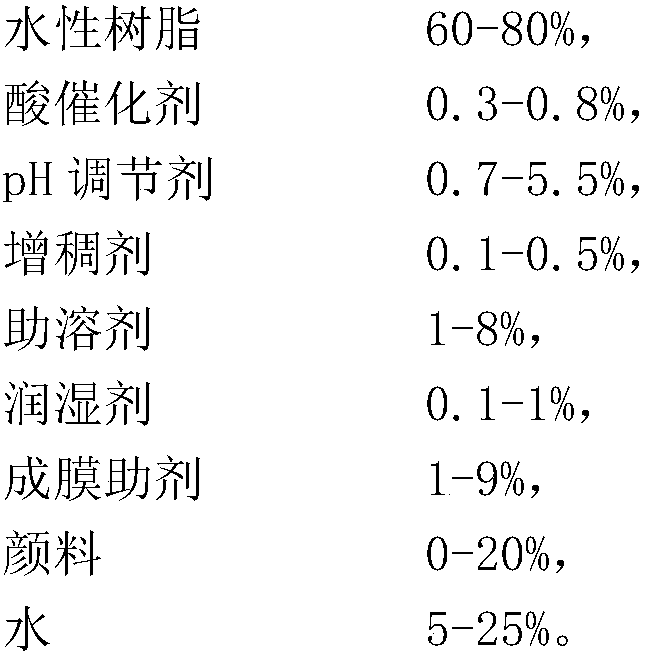Waterborne glass baking varnish
A glass baking paint, water-based technology, used in coatings, anti-corrosion coatings, epoxy resin coatings, etc., can solve the problems of low hardness and poor wear resistance, and achieve the effect of high hardness, excellent wear resistance and high gloss.
- Summary
- Abstract
- Description
- Claims
- Application Information
AI Technical Summary
Problems solved by technology
Method used
Image
Examples
Embodiment 1
[0018] A water-based glass baking varnish, by weight percentage, comprises the following components: 80% of water-based resin, 0.8% of acid catalyst, 5% of pH regulator, 0.1% of thickener, 1% of cosolvent, 0.1% of wetting agent, and Membrane aid 2%, pigment 0, water 11%.
[0019] The water-based resin is a 1:1 mixture of hydroxyl acrylic resin and epoxy acrylic resin, the acid catalyst is p-toluenesulfonic acid, the pH regulator is 2-amino-2-methyl-1-propanol, and the thickener is polyurethane and The polyacrylamide is mixed at a ratio of 1:1, the cosolvent is ethylene glycol butyl ether, the wetting agent is a silicone-based wetting agent, and the film-forming aid is propylene glycol butyl ether.
Embodiment 2
[0021] A water-based glass baking varnish comprises the following components by weight percentage: 75% of water-based resin, 0.7% of acid catalyst, 3.2% of pH regulator, 0.3% of thickener, 2.6% of cosolvent, 0.5% of wetting agent, and 4% film aid, 10% pigment, 3.7% water.
[0022] The water-based resin is a 1:1 mixture of epoxy acrylic resin and melamine resin, the acid catalyst is dodecylbenzenesulfonic acid, the pH regulator is N-methylethanolamine, and the thickener is polyacrylamide and polyvinyl alcohol 1:1 Mixing, the co-solvent is a 1:1 mixture of ethylene glycol butyl ether and diethylene glycol butyl ether, the wetting agent is an acetylene glycol wetting agent, and the film-forming aid is propylene glycol methyl ether acetate.
Embodiment 3
[0024] A water-based glass baking varnish, by weight percentage, comprises the following components: 70% of water-based resin, 0.5% of acid catalyst, 4.1% of pH regulator, 0.2% of thickener, 1.5% of cosolvent, 0.6% of wetting agent, and Film aid 1.5%, pigment 5%, water 16.6%.
[0025] The water-based resin is a 1:1 mixture of melamine resin and polyamide resin, the acid catalyst is dinonylnaphthalenesulfonic acid, the pH regulator is triethanolamine, and the thickener is a 1:1:1 mixture of polyacrylamide, polyvinyl alcohol and polyacrylic acid , the cosolvent is propylene glycol dibutyl ether, the wetting agent is a silicone wetting agent, and the film-forming aid is propylene glycol butyl ether.
PUM
 Login to View More
Login to View More Abstract
Description
Claims
Application Information
 Login to View More
Login to View More - R&D Engineer
- R&D Manager
- IP Professional
- Industry Leading Data Capabilities
- Powerful AI technology
- Patent DNA Extraction
Browse by: Latest US Patents, China's latest patents, Technical Efficacy Thesaurus, Application Domain, Technology Topic, Popular Technical Reports.
© 2024 PatSnap. All rights reserved.Legal|Privacy policy|Modern Slavery Act Transparency Statement|Sitemap|About US| Contact US: help@patsnap.com









